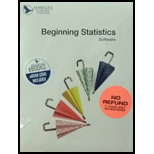
To find:
To write is there sufficient evidence to conclude at
Answer to Problem 10P
Solution:
There is no sufficient evidence to conclude that the makeup of your institution has significantly changed between Year 1 and Year 2.
Explanation of Solution
Consider two years that are not consecutive from which to collect data.
That is choosing the current academic year for Year 2 and the academic year four years earlier for Year 1.
Suppose the 2015 for year 1 and 2019 for year 2.
For year 1:
The number of students who were enrolled at your institution for each classification during year 1 is given below,
| 2015 | |
| Number of Freshmen Enrolled | 15 |
| Number of Sophomores Enrolled | 18 |
| Number of Juniors Enrolled | 21 |
| Number of Seniors Enrolled | 73 |
| Total Number of Students Enrolled | 127 |
Let
Mathematically, we can write the null and alternative hypothesis for four different students as follows,
Let‘s calculate the expected value for year 1. Since we are assuming that the proportion percentages stated for the student in year 1 are not incorrect is calculated as follows,
And,
For year 2:
The number of students who were enrolled at your institution for each classification during year 2 is given below,
| 2015 | |
| Number of Freshmen Enrolled | 24 |
| Number of Sophomores Enrolled | 20 |
| Number of Juniors Enrolled | 19 |
| Number of Seniors Enrolled | 20 |
Let
Mathematically, we can write the null and alternative hypothesis for four different students as follows,
| 2019 | |
| Percentage of Freshmen Enrolled | 28.92% |
| Percentage of Sophomores Enrolled | 24.10% |
| Percentage of Juniors Enrolled | 22.89% |
| Percentage of Seniors Enrolled | 24.10% |
Let‘s calculate the expected value for year 2. Since we are assuming that the proportion percentages stated for the student in year 2 are not incorrect is calculated as follows,
And,
Formula for calculating test statistic for a Chi-Square test for goodness of fit:
The test statistic for a chi-square test for goodness of fit is given below,
Where Oi, is the observed frequency for the ith possible outcome and Ei is the expected frequency for the ith possible outcome and n is the sample size.
From the above table represent the value of n for year 1 is 127 and for year 2 is 83.
The following table represents the test statistic,
| Year 1 | |||||
| Category | Observed Values | Expected values | |||
| Freshman | 15 | 14.9987 | 0.0013 | ||
| Sophomore | 18 | 17.9959 | 0.0041 | ||
| Junior | 21 | 21.0058 | -0.0058 | ||
| Senior | 73 | 72.9996 | 0.0004 | ||
| Year 2 | |||||
| Freshman | 24 | 24.0036 | -0.0036 | ||
| Sophomore | 20 | 20.003 | -0.003 | ||
| Junior | 19 | 18.9987 | 0.0013 | ||
| Senior | 20 | 20.003 | -0.003 | ||
The calculated test statistic for year 1 and for year 2 is
Degrees of freedom in a Chi-square test for goodness of fit:
In a chi-square test for goodness of fit the number of degrees of freedom for the chi-square distribution of the test statistic is given by,
Where k is the number of possible outcomes for each trial.
Rejection Region for Chi-Square Test for Association:
Reject the null hypothesis,
From the given information k = 4.
Substitute the above values in the formula of degrees of freedom to get the following,
Conclusion:
Use the level of significance of
Use the “Area to the right of the critical value
Year 1:
The test statistic value is
By using the above condition we fail to reject the null hypothesis.
Since
Year 2:
The test statistic value is
By using the above condition we fail to reject the null hypothesis.
Since
The null hypothesis will be accepted for both year 1 and year 2.
Hence the proportion percentage for the students does not vary for both year 1 and year 2.
So, there is no sufficient evidence to conclude that the makeup of your institution has significantly changed between Year 1 and Year 2. Since the proportion percentage will not vary between two years. That is, percentage of students in every classification in year 1will be equal to percentage of students in every classification in year 2.
Final statement:
There is no sufficient evidence to conclude that the makeup of your institution has significantly changed between Year 1 and Year 2.
Want to see more full solutions like this?
Chapter 10 Solutions
BEGINNING STATISTICS-CD (NEW ONLY)
 MATLAB: An Introduction with ApplicationsStatisticsISBN:9781119256830Author:Amos GilatPublisher:John Wiley & Sons Inc
MATLAB: An Introduction with ApplicationsStatisticsISBN:9781119256830Author:Amos GilatPublisher:John Wiley & Sons Inc Probability and Statistics for Engineering and th...StatisticsISBN:9781305251809Author:Jay L. DevorePublisher:Cengage Learning
Probability and Statistics for Engineering and th...StatisticsISBN:9781305251809Author:Jay L. DevorePublisher:Cengage Learning Statistics for The Behavioral Sciences (MindTap C...StatisticsISBN:9781305504912Author:Frederick J Gravetter, Larry B. WallnauPublisher:Cengage Learning
Statistics for The Behavioral Sciences (MindTap C...StatisticsISBN:9781305504912Author:Frederick J Gravetter, Larry B. WallnauPublisher:Cengage Learning Elementary Statistics: Picturing the World (7th E...StatisticsISBN:9780134683416Author:Ron Larson, Betsy FarberPublisher:PEARSON
Elementary Statistics: Picturing the World (7th E...StatisticsISBN:9780134683416Author:Ron Larson, Betsy FarberPublisher:PEARSON The Basic Practice of StatisticsStatisticsISBN:9781319042578Author:David S. Moore, William I. Notz, Michael A. FlignerPublisher:W. H. Freeman
The Basic Practice of StatisticsStatisticsISBN:9781319042578Author:David S. Moore, William I. Notz, Michael A. FlignerPublisher:W. H. Freeman Introduction to the Practice of StatisticsStatisticsISBN:9781319013387Author:David S. Moore, George P. McCabe, Bruce A. CraigPublisher:W. H. Freeman
Introduction to the Practice of StatisticsStatisticsISBN:9781319013387Author:David S. Moore, George P. McCabe, Bruce A. CraigPublisher:W. H. Freeman





